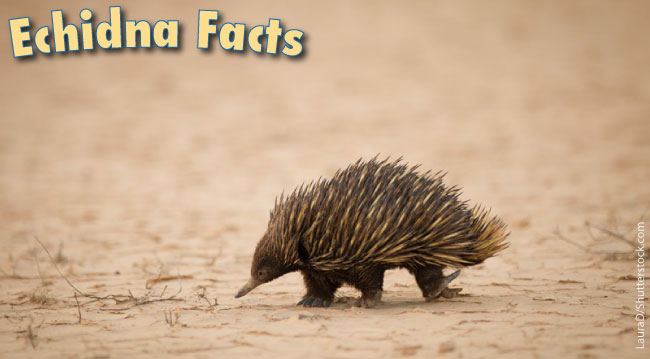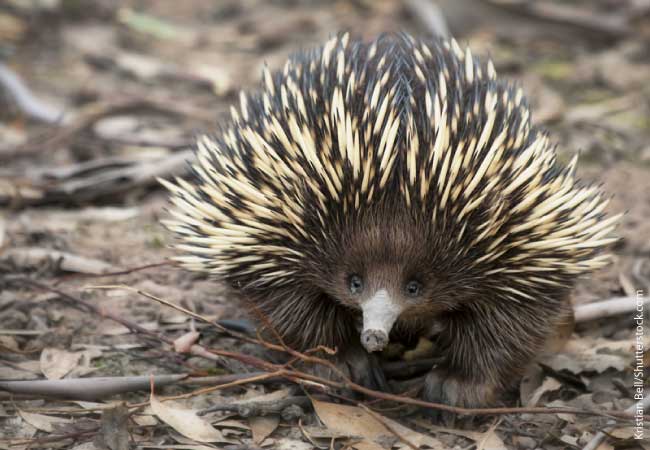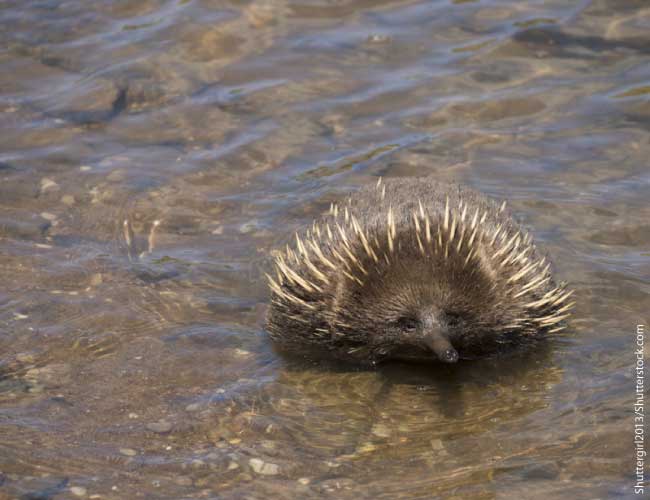The echidna is a spiny, ant-eating animal that lives in Australia and New Guinea. What makes echidnas really special is that they are egg-laying mammals! This page contains information on the echidna and a list of echidna facts for kids.
Let's learn more about this amazing animal.
This article is part of the Active Wild Australian Animals series.
Echidna Information: The Spiny Anteater
The echidna (ih-kid-nuh) is a native of Australia and New Guinea. With its spiny back and long, pointy snout, one might mistake it for a porcupine or a hedgehog, but in fact it is related to neither.
The echidna belongs to the Tachiglossidae family, which is Greek for “fast tongue.” This is fitting because the echidna uses that long beak and sticky tongue to slurp up its favorite food: ants! In fact, the echidna’s nickname is ‘spiny anteater’.
Echidnas Lay Eggs! How Can They Be Mammals?
Echidnas are curious creatures. In many ways they don't look much like mammals: they have spines, and they lay eggs.
Despite this, echidnas do possess the characteristics necessary to be classified as mammals. They have fur (their spines are actually stiff hairs), they are warm-blooded, and they produce milk for their young.
But what about the eggs?
This is what makes echidnas special. They are monotremes: egg-laying mammals.
The only other egg-laying mammal is the platypus. The four echidna species and the platypus are the only monotremes still in existence.
You can watch the video below to get a better idea of what an echidna looks like, how it moves, and how big it is:
It’s a Fact: Echidna Babies Are Called Puggles!
Echidnas mate during the winter months of July through August. When the female echidna produces an egg, she curls up, causing the leathery egg to drop into the soft folds of her stomach, which make a pouch. After ten days, the egg hatches, and a baby echidna, called a puggle, is born! It has no spines or fur.
The puggle lives in its mother’s pouch, much like a kangaroo with her joey, until is two months old. During this time, the puggle sucks the milk from its mother’s pores that drips onto the hairs in her pouch. The mother then hides the puggle safely in a burrow, visiting once a week to feed her baby. At seven months old, the young echidna has developed enough to live on its own.
How Many Species?
There are four species of echidna: the short-beaked echidna, and three long-beaked echidnas.
Echidna Species
- Short-beaked echidna (Tachyglossus aculeatus)
- Western long-beaked echidna (Zaglossus bruijni)
- Sir David's long-beaked echidna (Zaglossus attenboroughi)
- Eastern long-beaked echidna (Zaglossus bartoni)
Sir David's long-beaked echidna (Zaglossus attenboroughi) is named after the famous British naturalist and broadcaster Sir David Attenborough.
Short-Beaked Echidna
The short-beaked echidna lives in both Australia and New Guinea and is the most populous echidna species. You can find it in the lowlands, the desert, and the highland forests.
Although the echidna is a warm-blooded mammal, it cannot tolerate either very cold or very hot temperatures. If you are able to spot one at all, it will likely be early in the morning or at night during the summer, or at noon in the winter.
Long-Beaked Echidnas
There are three species of long-beaked echidna; all live in New Guinea. Little is known about them because they live high up in the mountain forests where observing them is difficult.
The long-beaked echidnas are larger than the short-beaked echidna, and eat worms rather than ants.
Echidna Habitat And Diet
Echidnas are solitary creatures, and they make their home in various places within their territory. One day, they might live in a burrow (nest in the ground), the next in a hollow log, and at other times in a cave or some underbrush.
Echidnas are good swimmers, but they don’t like the rain and will hide from it for days if necessary. Luckily, echidnas don’t need to eat very often; one huge meal will tide them over for several days. A termite infested log is the perfect feast!
Defence Mechanisms
If it senses danger, the shy echidna has a few ways to protect itself. First, its brown or black color provides camouflage to keep it out of danger in the first place. Second, when it is on hard ground, it may curl up into a ball, exposing only its spines and keeping its spineless stomach and snout protected. But, if it is on soft ground, it does something really cool. With its short muscular front and hind legs and sharp claws, the echidna digs away at the ground and sinks right down into it, leaving only its spines out for protection against a predator. Finally, the echidna is also able to wedge itself in rock crevices with its strong body, making it impossible for predators to pull it out.
Echidna Threats
The only animals fierce enough to tackle an echidna are the dingo (a wild dog), the goanna (a large lizard), wild cats and foxes. Snakes will also sneak in and eat puggles.
Are Echidnas Endangered?
Even with so few predators, three of the four echidna species (the Sir David's Long-beaked Echidna, Eastern Long-beaked Echidna and Western Long-beaked Echidna) are critically endangered. This is due to excessive hunting and destruction of their forest habitat.
Echidna Facts – Conclusion
The echidna is a fascinating creature: a unique blend of mammal, reptile, and marsupial. If you are lucky enough to find one, remember to respect its privacy and keep your hands away from those sharp spines!
Top 10 Echidna Facts
- Echidnas are short, stout creatures. They can average 30-79 cm in length and weigh up from 3.5 to 22 lbs.
- The oldest echidna raised by a human lived to 50 years old. In the wild, the oldest recorded echidna lived to 45 years.
- The echidna has no teeth. It uses its tongue and the roof of its mouth to mash up the termites and ants it eats.
- Echidnas are edible, and have been hunted for food.
- The echidna’s mouth is like a long tube with a tongue inside. It opens at the end of the snout, along with the nostrils.
- When echidnas are born, they are the size of a jellybean (12mm).
- The echidna, which means “snake viper,” is named after a Greek goddess by the same name. She was a terrible monster with the upper body of a woman and the lower body of a snake. Legend has it that she was finally destroyed by a young warrior who filled her body with sharp arrows, looking very much like the sharp spines you find on the echidna’s back.
- The long-beaked echidna species have shorter tongues than the short-beaked echidnas.
- There are albino echidnas, too. They are white with pink eyes.
- Mammals that lay eggs are called monotremes. You can read more about monotremes at Wikipedia.
Discover More with Active Wild
We hope that you have enjoyed reading these echidna facts. It’s always sad to learn that a cool animal like the echidna is endangered, so spread the word and tell everyone you know about echidnas!
You can discover more awesome Australian animals on this page: Australian Animals List with Pictures & Facts





